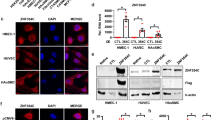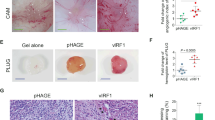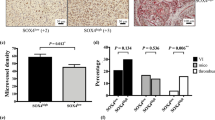Abstract
SP100 was first identified as a nuclear autoimmune antigen and is a constituent of the nuclear body. SP100 interacts with the ETS1 transcription factor, and we have previously shown that SP100 reduces ETS1-DNA binding and inhibits ETS1 transcriptional activity on the MMP1 and uPA promoters. We now demonstrate that SP100 expression is upregulated by interferons, which have been shown to be antiangiogenic, in primary endothelial cells. As ETS1 is functionally important in promoting angiogenesis, we tested the hypothesis that ETS1 activity is negatively modulated by SP100 in endothelial cells. SP100 directly antagonizes ETS1-mediated morphological changes in human umbilical vein endothelial cell (HUVEC) network formation and reduces HUVEC migration and invasion. To further understand the functional relationship between ETS1 and SP100, cDNA microarray analysis was utilized to assess reprogramming of gene expression by ETS1 and SP100. A subset of the differentially regulated genes, including heat-shock proteins (HSPs) H11, HSPA1L, HSPA6, HSPA8, HSPE1 and AXIN1, BRCA1, CD14, CTGF (connective tissue growth factor), GABRE (gamma-aminobutyric acid A receptor epsilon), ICAM1, SNAI1, SRD5A1 (steroid-5-alpha-reductase 1) and THY1, were validated by real-time PCR and a majority showed reciprocal expression in response to ETS1 and SP100. Interestingly, genes that are negatively regulated by ETS1 and upregulated by SP100 have antimigratory or antiangiogenic properties. Collectively, these data indicate that SP100 negatively modulates ETS1-dependent downstream biological processes.
This is a preview of subscription content, access via your institution
Access options
Subscribe to this journal
Receive 50 print issues and online access
$259.00 per year
only $5.18 per issue
Buy this article
- Purchase on Springer Link
- Instant access to full article PDF
Prices may be subject to local taxes which are calculated during checkout







Similar content being viewed by others
References
Babic AM, Chen CC and Lau LF . (1999). Mol. Cell. Biol., 19, 2958–2966.
Baker KM, Wei G, Schaffner AE and Ostrowski MC . (2003). J. Biol. Chem., 278, 17876–17884.
Bell SE, Mavila A, Salazar R, Bayless KJ, Kanagala S, Maxwell SA and Davis GE . (2001). J. Cell Sci., 114, 2755–2773.
Brigstock DR . (2002). Angiogenesis, 5, 153–165.
Carmeliet P and Jain RK . (2000). Nature, 407, 249–257.
Chang CC, Shih JY, Jeng YM, Su JL, Lin BZ, Chen ST, Chau YP, Yang PC and Kuo ML . (2004). J. Natl. Cancer Inst., 96, 364–375.
Chaussabel D, Semnani RT, McDowell MA, Sacks D, Sher A and Nutman TB . (2003). Blood, 102, 672–681.
Chaussabel D and Sher A . (2002). Genome. Biol., 3, RESEARCH0055.1–0055.16.
Chen Z, Fisher RJ, Riggs CW, Rhim JS and Lautenberger JA . (1997). Cancer Res., 57, 2013–2019.
Cui Y, Zhou M and Wong WH . (2004). OMICS, 8, 106–117.
Czuwara-Ladykowska J, Sementchenko VI, Watson DK and Trojanowska M . (2002). J. Biol. Chem., 277, 20399–20408.
Dahlquist KD, Salomonis N, Vranizan K, Lawlor SC and Conklin BR . (2002). Nat. Genet., 31, 19–20.
Dandre F and Owens GK . (2004). Am. J. Physiol. Heart Circ. Physiol., 286, H2042–H2051.
Davies PA, Hanna MC, Hales TG and Kirkness EF . (1997). Nature, 385, 820–823.
Delannoy-Courdent A, Mattot V, Fafeur V, Fauquette W, Pollet I, Calmels T, Vercamer C, Boilly B, Vandenbunder B and Desbiens X . (1998). J. Cell Sci., 111 (Part 11), 1521–1534.
Dirkx AE, Oude Egbrink MG, Kuijpers MJ, van der Niet ST, Heijnen VV, Bouma-ter Steege JC, Wagstaff J and Griffioen AW . (2003). Cancer Res., 63, 2322–2329.
Dittmer J . (2003). Mol. Cancer, 2, 29.
Doniger SW, Salomonis N, Dahlquist KD, Vranizan K, Lawlor SC and Conklin BR . (2003). Genome Biol., 4, R7.
Edwards AD, Chaussabel D, Tomlinson S, Schulz O, Sher A and Reis e Sousa C . (2003). J. Immunol., 171, 47–60.
Entschladen F, Drell TLt, Lang K, Joseph J and Zaenker KS . (2004). Lancet Oncol., 5, 254–258.
Folkman J . (1971). N. Engl. J. Med., 285, 1182–1186.
Folkman J . (2000) Holland JF (ed). Cancer Medicine. B.C. Decker: Hamilton, Ontario; New York, pp. 132–152.
Folkman J and Hanahan D . (1991). Princess Takamatsu Symp., 22, 339–347.
Freeman BC and Yamamoto KR . (2002). Science, 296, 2232–2235.
Galea E, Santizo R, Feinstein DL, Adamsom P, Greenwood J, Koenig HM and Pelligrino DA . (2002). Neuroreport, 13, 1469–1472.
Gerritsen ME, Soriano R, Yang S, Ingle G, Zlot C, Toy K, Winer J, Draksharapu A, Peale F, Wu TD and Williams PM . (2002). Physiol. Genom., 10, 13–20.
Goetze S, Kintscher U, Kaneshiro K, Meehan WP, Collins A, Fleck E, Hsueh WA and Law RE . (2001). Atherosclerosis, 159, 93–101.
Griffioen AW, Damen CA, Martinotti S, Blijham GH and Groenewegen G . (1996). Cancer Res., 56, 1111–1117.
Guldner HH, Szostecki C, Grotzinger T and Will H . (1992). J. Immunol., 149, 4067–4073.
Hanai J, Gloy J, Karumanchi SA, Kale S, Tang J, Hu G, Chan B, Ramchandran R, Jha V, Sukhatme VP and Sokol S . (2002). J. Cell Biol., 158, 529–539.
Harmey JH, Bucana CD, Lu W, Byrne AM, McDonnell S, Lynch C, Bouchier-Hayes D and Dong Z . (2002). Int. J. Cancer, 101, 415–422.
Harris AL . (2002). Nat. Rev. Cancer, 2, 38–47.
Hashimoto G, Inoki I, Fujii Y, Aoki T, Ikeda E and Okada Y . (2002). J. Biol. Chem., 277, 36288–36295.
Hastings MM, Milot J, Barsoum-Homsy M, Hershon L, Dubois J and Leclerc JM . (1997). J. AAPOS, 1, 226–230.
He TC, Zhou S, da Costa LT, Yu J, Kinzler KW and Vogelstein B . (1998). Proc. Natl. Acad. Sci. USA, 95, 2509–2514.
Hsu T, Trojanowska M and Watson DK . (2004). J. Cell. Biochem., 91, 896–903.
Igarashi T, Abe M, Oikawa M, Nukiwa T and Sato Y . (2001). Tohoku J. Exp. Med., 194, 35–43.
Inoki I, Shiomi T, Hashimoto G, Enomoto H, Nakamura H, Makino K, Ikeda E, Takata S, Kobayashi K and Okada Y . (2002). FASEB J., 16, 219–221.
Iwasaka C, Tanaka K, Abe M and Sato Y . (1996). J. Cell. Physiol., 169, 522–531.
Jang HS, Kim HJ, Kim JM, Lee YS, Kim KL, Kim JA, Lee JY, Suh W, Choi JH, Jeon ES, Byun J and Kim DK . (2004). Mol. Ther., 9, 464–474.
Kawai H, Li H, Chun P, Avraham S and Avraham HK . (2002). Oncogene, 21, 7730–7739.
Kevil CG, Orr AW, Langston W, Mickett K, Murphy-Ullrich J, Patel RP, Kucik DF and Bullard DC . (2004). J. Biol. Chem., 279, 19230–19238.
Kishida M, Koyama S, Kishida S, Matsubara K, Nakashima S, Higano K, Takada R, Takada S and Kikuchi A . (1999). Oncogene, 18, 979–985.
Kishida S, Yamamoto H, Ikeda S, Kishida M, Sakamoto I, Koyama S and Kikuchi A . (1998). J. Biol. Chem., 273, 10823–10826.
Kita D, Takino T, Nakada M, Takahashi T, Yamashita J and Sato H . (2001). Cancer Res., 61, 7985–7991.
Kumar P, Judson I, Nicholson AG and Ladas G . (2002). J. Thorac. Cardiovasc. Surg., 124, 404–406.
Lee E, Salic A, Kruger R, Heinrich R and Kirschner MW . (2003). PLoS Biol., 1, E10.
Lee WS, Jain MK, Arkonac BM, Zhang D, Shaw SY, Kashiki S, Maemura K, Lee SL, Hollenberg NK, Lee ME and Haber E . (1998). Circ. Res., 82, 845–851.
Lelievre E, Lionneton F, Soncin F and Vandenbunder B . (2001). Int. J. Biochem. Cell. Biol., 33, 391–407.
Li R, Pei H and Papas T . (1999). Proc. Natl. Acad. Sci. USA, 96, 3876–3881.
Li R, Pei H, Watson DK and Papas TS . (2000). Oncogene, 19, 745–753.
Li WW, Grayson G, Folkman J and D'Amore PA . (1991). Invest. Ophthalmol. Vis. Sci., 32, 2906–2911.
Lincoln DW, Phillips II PG and Bove K . (2003). Breast Cancer Res. Treat., 78, 167–178.
Marler JJ, Rubin JB, Trede NS, Connors S, Grier H, Upton J, Mulliken JB and Folkman J . (2002). Pediatrics, 109, E37.
Mattot V, Vercamer C, Soncin F, Calmels T, Huguet C, Fafeur V and Vandenbunder B . (2000). Oncogene, 19, 762–772.
Mercurio S, Latinkic B, Itasaki N, Krumlauf R and Smith JC . (2004). Development, 131, 2137–2147.
Nakano T, Abe M, Tanaka K, Shineha R, Satomi S and Sato Y . (2000). J. Cell. Physiol., 184, 255–262.
Oikawa M, Abe M, Kurosawa H, Hida W, Shirato K and Sato Y . (2001). Biochem. Biophys. Res. Commun., 289, 39–43.
Oikawa T and Yamada T . (2003). Gene, 303, 11–34.
Okubo T, Truong TK, Yu B, Itoh T, Zhao J, Grube B, Zhou D and Chen S . (2001). Cancer Res., 61, 1338–1346.
Ortega A . (2003). Trends Pharmacol. Sci., 24, 151–154.
Pelicano L, Li F, Schindler C and Chelbi-Alix MK . (1997). Oncogene, 15, 2349–2359.
Pollet I, Opina CJ, Zimmerman C, Leong KG, Wong F and Karsan A . (2003). Blood, 102, 1740–1742.
Pourtier-Manzanedo A, Vercamer C, Van Belle E, Mattot V, Mouquet F and Vandenbunder B . (2003). Oncogene, 22, 1795–1806.
Ramakers C, Ruijter JM, Deprez RH and Moorman AF . (2003). Neurosci. Lett., 339, 62–66.
Raouf A, Li V, Kola I, Watson DK and Seth A . (2000). Oncogene, 19, 1969–1974.
Roca C, Primo L, Valdembri D, Cividalli A, Declerck P, Carmeliet P, Gabriele P and Bussolino F . (2003). Cancer Res., 63, 1500–1507.
Roy J, Audette M and Tremblay MJ . (2001). J. Biol. Chem., 276, 14553–14561.
Saeed AI, Sharov V, White J, Li J, Liang W, Bhagabati N, Braisted J, Klapa M, Currier T, Thiagarajan M, Sturn A, Snuffin M, Rezantsev A, Popov D, Ryltsov A, Kostukovich E, Borisovsky I, Liu Z, Vinsavich A, Trush V and Quackenbush J . (2003). Biotechniques, 34, 374–378.
Sato Y . (2001). Cell. Struct. Funct., 26, 19–24.
Schneikert J, Peterziel H, Defossez PA, Klocker H, Launoit Y and Cato AC . (1996). J. Biol. Chem., 271, 23907–23913.
Sementchenko VI and Watson DK . (2000). Oncogene, 19, 6533–6548.
Semenza GL . (1998). Curr. Opin. Genet. Dev., 8, 588–594.
Shimizu S, Kageyama M, Yasuda M, Sasaki D, Naito S, Yamamoto T and Kiuchi Y . (2004). Int. J. Biochem. Cell. Biol., 36, 114–122.
Shimo T, Nakanishi T, Nishida T, Asano M, Kanyama M, Kuboki T, Tamatani T, Tezuka K, Takemura M, Matsumura T and Takigawa M . (1999). J. Biochem. (Tokyo), 126, 137–145.
St Croix B, Rago C, Velculescu V, Traverso G, Romans KE, Montgomery E, Lal A, Riggins GJ, Lengauer C, Vogelstein B and Kinzler KW . (2000). Science, 289, 1197–1202.
Sturn A, Quackenbush J and Trajanoski Z . (2002). Bioinformatics, 18, 207–208.
Thiery JP . (2002). Nat. Rev. Cancer, 2, 442–454.
Tolwinski NS and Wieschaus E . (2004). Trends Genet., 20, 177–181.
Tomita N, Morishita R, Taniyama Y, Koike H, Aoki M, Shimizu H, Matsumoto K, Nakamura T, Kaneda Y and Ogihara T . (2003). Circulation, 107, 1411–1417.
Triantafilou M and Triantafilou K . (2002). Trends Immunol., 23, 301–304.
Tryfonas GI, Tsikopoulos G, Liasidou E, Gavopoulos S, Georgakis G, Badouraki M and Soultanides C . (1998). Pediatr. Surg. Int., 13, 590–593.
Vandenbunder B, Pardanaud L, Jaffredo T, Mirabel MA and Stehelin D . (1989). Development, 107, 265–274.
Vega S, Morales AV, Ocana OH, Valdes F, Fabregat I and Nieto MA . (2004). Genes Dev., 18, 1131–1143.
von Marschall Z, Scholz A, Cramer T, Schafer G, Schirner M, Oberg K, Wiedenmann B, Hocker M and Rosewicz S . (2003). J. Natl. Cancer Inst., 95, 437–448.
Wang L, Wu WZ, Sun HC, Wu XF, Qin LX, Liu YK, Liu KD and Tang ZY . (2003). J. Gastrointest. Surg., 7, 587–594.
Watanabe D, Takagi H, Suzuma K, Suzuma I, Oh H, Ohashi H, Kemmochi S, Uemura A, Ojima T, Suganami E, Miyamoto N, Sato Y and Honda Y . (2004). Am. J. Pathol., 164, 1827–1835.
Wernert N, Raes MB, Lassalle P, Dehouck MP, Gosselin B, Vandenbunder B and Stehelin D . (1992). Am. J. Pathol., 140, 119–127.
Wernert N, Stanjek A, Kiriakidis S, Hugel A, Jha HC, Mazitschek R and Giannis A . (1999). Angew. Chem. Int. Ed. Engl., 38, 3228–3231.
Wu X, Pang ST, Sahlin L, Blanck A, Norstedt G and Flores-Morales A . (2003). Biol. Reprod., 69, 1308–1317.
Yasuda M, Ohzeki Y, Shimizu S, Naito S, Ohtsuru A, Yamamoto T and Kuroiwa Y . (1999). Life Sci., 64, 249–258.
Yordy JS, Li R, Sementchenko VI, Pei H, Muise-Helmericks RC and Watson DK . (2004). Oncogene, 23, 6654–6665.
Acknowledgements
We thank Joan Hebert from the Stanford Functional Genomics Facility for help in obtaining the microarrays and annotated files, and Nicki Chin from the Stanford Functional Genomics Facility and Roger Wagner from the Stanford Division of Cardiovascular Medicine, Falk Cardiovascular Research Center for assistance with microarray protocols. We thank Jordan Blessing from ScopeTronix for customizing the adapter used for the afocal microscopy, and Tom Bullington and Chuck Westfall from Canon USA for help in initially testing the digital SLR Canon cameras. This work was supported in part by grants from the National Institutes of Health Grant P01CA78582 and MUSC Institutional Research Funds of 2003–04 (DKW) and by the Wachovia Hollings Cancer Center scholarship and a Cato scholarship (JSY).
Author information
Authors and Affiliations
Corresponding author
Additional information
Supplementary information accompanies the paper on Oncogene website (http://www.nature.com/onc).
Rights and permissions
About this article
Cite this article
Yordy, J., Moussa, O., Pei, H. et al. SP100 inhibits ETS1 activity in primary endothelial cells. Oncogene 24, 916–931 (2005). https://doi.org/10.1038/sj.onc.1208245
Received:
Revised:
Accepted:
Published:
Issue Date:
DOI: https://doi.org/10.1038/sj.onc.1208245
Keywords
This article is cited by
-
Role of ZBTB7A zinc finger in tumorigenesis and metastasis
Molecular Biology Reports (2021)
-
Human Cytomegalovirus Influences Host circRNA Transcriptions during Productive Infection
Virologica Sinica (2021)
-
Longitudinal expression profiling of CD4+ and CD8+ cells in patients with active to quiescent giant cell arteritis
BMC Medical Genomics (2018)
-
Custom CGH array profiling of copy number variations (CNVs) on chromosome 6p21.32 (HLA locus) in patients with venous malformations associated with multiple sclerosis
BMC Medical Genetics (2010)



